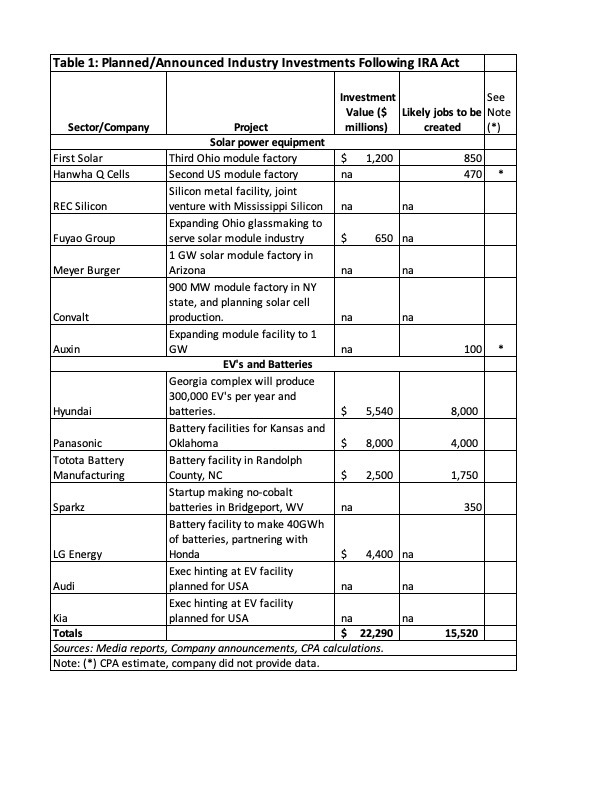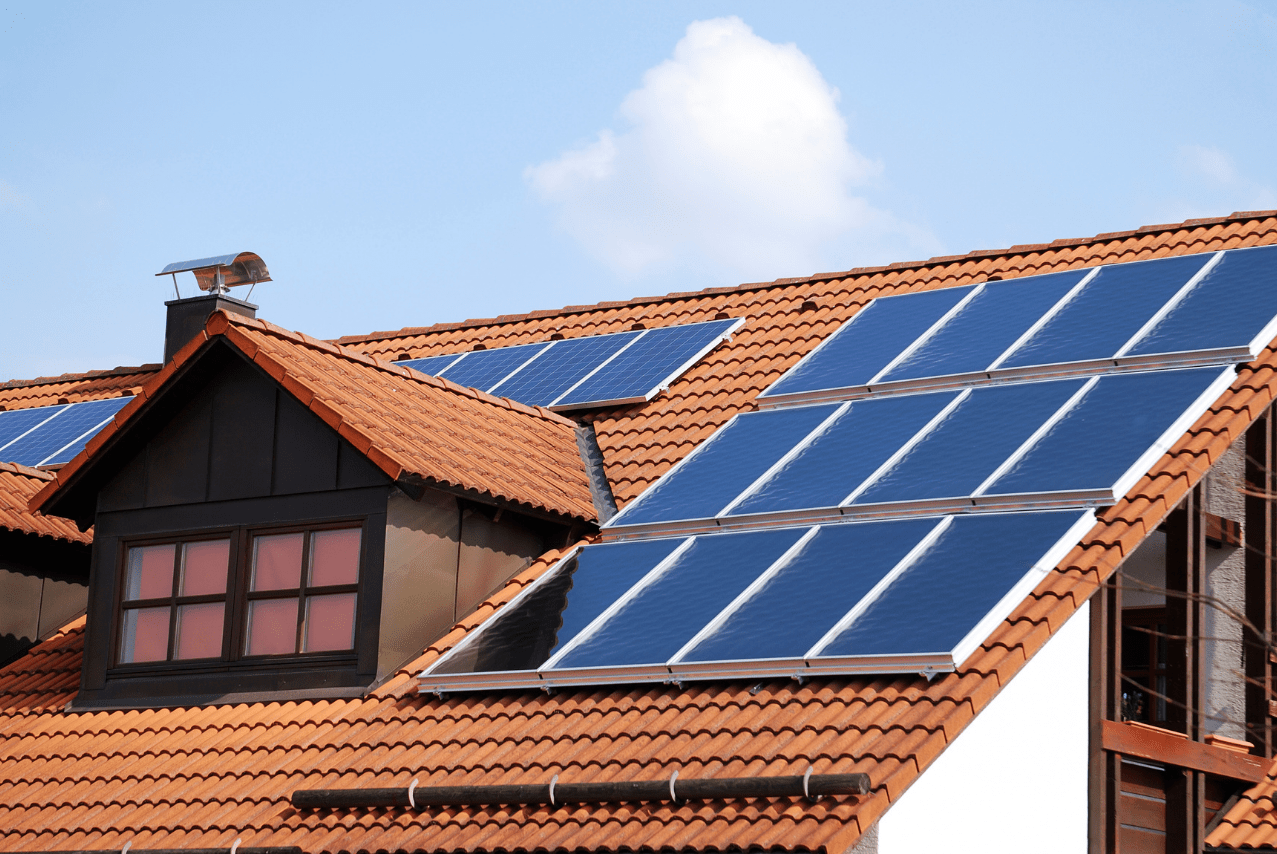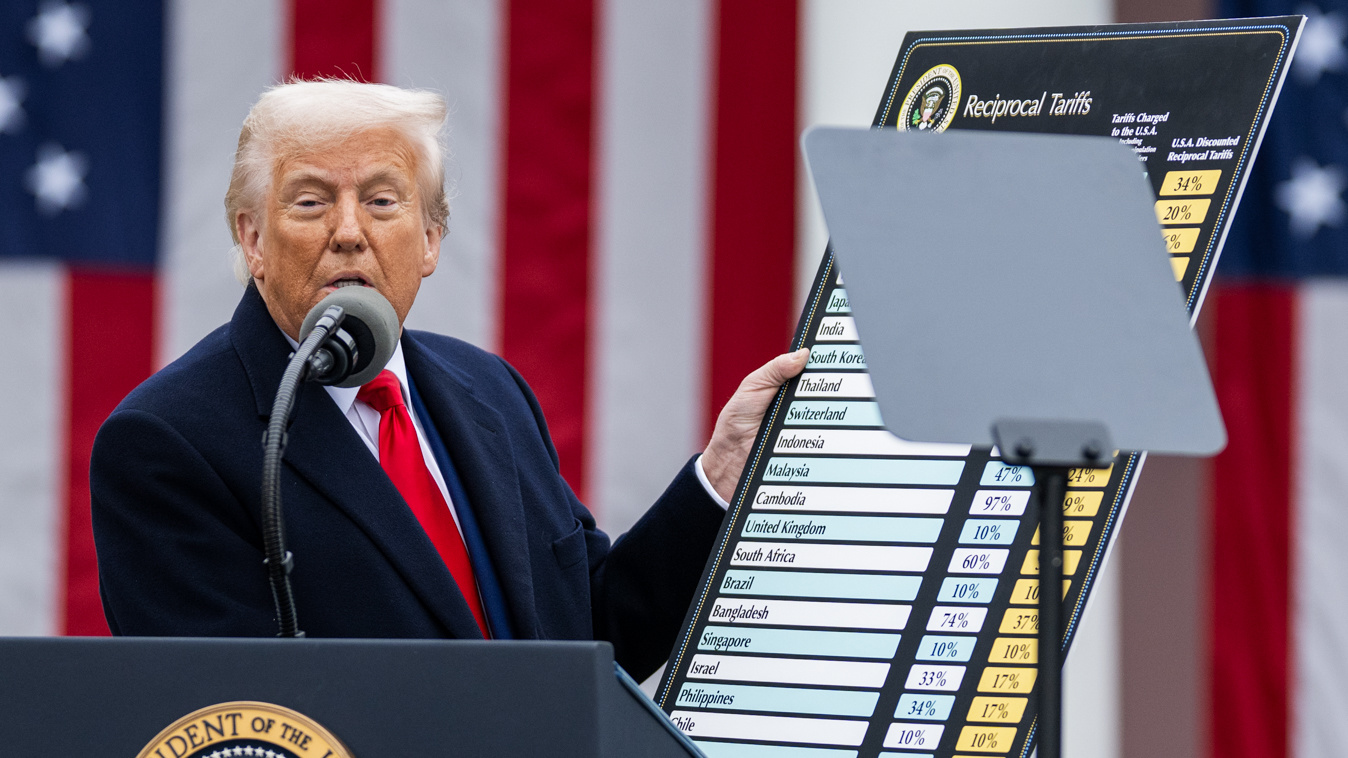$22 Billion of Investment to Create 15,000 Jobs
The manufacturing incentives tucked into the Inflation Reduction Act have unleashed a tidal wave of investment in U.S. manufacturing unlike any we have seen in decades. According to CPA calculations, and our calculations are a work in progress, so far $22 billion of investment dollars have been promised for U.S. manufacturing operations, and these new facilities will employ some 15,000 people. (See Table 1 for details.) Those totals are likely to be revised upwards as many projects have yet to be announced and will likely lead to thousands more jobs and billions more dollars.
The announced investments are concentrated in several industries: renewable energy equipment, electric vehicles (EVs), rechargeable batteries, and critical minerals. All these investments are in response to tax credits tucked into the 730-page Inflation Reduction Act which, despite the name, is mostly about promoting renewable energy policies in the U.S., as well as critical mineral production. The formulas for the tax credits are complex as manufacturers and producers are still awaiting the Internal Revenue Service’s clarifications on the details of how the law will be interpreted and applied. But the credits are so substantial, and the opportunities in these industries are so large, that companies are not waiting to announce big plans.

Solar energy equipment companies were already familiar with the terms of the tax credits, since they were developed over a year ago as part of Senator Jon Ossoff’s Solar Energy Manufacturing Act. The credits extend to companies throughout the solar energy supply chain, from the polysilicon that is the raw material of a solar cell, through the solar ingots, wafers, cells, and six-foot-tall solar modules that are the most common form of the finished product. For example, a typical solar module might generate 500 watts of power and sell for $200. The IRA tax credit of 7 cents a watt means that the company making that panel would be able to claim $35 of tax credit on each panel sold. One solar company recently reported that it is selling modules this year at an average of 30 cents a watt with a gross profit margin of 8%, for gross profit of just 2.4 cents per watt. Assuming this company paid corporate tax at the standard 21% rate, that 7 cent tax credit would add 1.4 cents per watt, or 58% to its gross profit. Financial analysts who follow solar companies labeled the IRA a “game-changer” for these stocks, which have shot up since August.
Swiss solar panel manufacturer, Meyer Burger, now building a module plant in Arizona, recently published a letter in which it urged the European Union to follow the Biden administration with big incentives to build solar manufacturing within Europe. In its letter, Meyer Burger said:
“The IRA [Inflation Reduction Act] provides clear and tangible Operating Expenses (OpEx) and Capital Expenditure (CapEx) benefits that guarantee predictable operational support for almost 10 years…we have seen gigawatts of investment decisions and announcements within a matter of weeks.”[1]
Since passage of the IRA in August, a series of solar module manufacturers have announced investments or expansions to their U.S. manufacturing footprint. First Solar, the largest U.S.-based solar module manufacturer announced in August plans to build a new module factory in the southeastern U.S. and expand its three facilities in Ohio, bringing its total U.S. production to over 10 gigawatts a year. That means this one company would on its own produce about as much as all U.S. manufacturers produced last year.
In addition, Korean-owned Hanwha Q Cells, the other large U.S. producer, is planning to build a second U.S. facility in Georgia with capacity of some 1.4 gigawatts. Q Cells is also looking at locations in the southern U.S. for a third module facility. Meyer Burger’s planned facility in Arizona will have capacity for 1 gigawatt a year. Another new entrant to the U.S. market, Convalt, is building a plant in upstate New York with capacity for 900 megawatts, targeted to rise to 4 gigawatts by December 2024. California-based Auxin Solar is also working on expansion plans likely to make it a gigawatt-level module producer.
Together, these new facilities will likely create over 2,000 jobs and produce half of annual U.S. solar module needs, which are themselves likely to rise by double-digit percentages each year.
Equally important, Q Cells and Convalt intend to invest in the upstream parts of the solar module production process, including polysilicon, solar wafers and cells. These investments hold out the hope of building out a complete U.S.-based solar supply chain, ultimately freeing the U.S. from dependence on China. Today China has a stranglehold on the solar module market through its 90%+ domination of the global supply of solar ingots and wafers. Smaller U.S.-based manufacturers are also looking at entering the upstream part of the solar supply chain.
Electric Vehicles Will be Made in America
The IRA’s effect on the auto industry, and the lithium batteries that supply it, has been just as dramatic. The IRA provides for a tax credit of up to $7500 on an electric vehicle (EV), provided the vehicle is assembled in North America. If the vehicle meets that first threshold, then half of the credit is available if over 50% of the value of the battery is added (i.e. manufactured) in the U.S. The other half of the $7500 is available if a minimum portion of the minerals within the batteries were mined in the U.S. The details of the formula are complex and still require interpretation by the Internal Revenue Service.
A consumer tax credit like this likely has even more impact on an industry than the solar tax credit. The majority of solar modules are purchased by utility companies and they are specified by engineers, who look primarily at technical criteria like electricity output, cost per watt, reliability, and module lifespan. Automobile manufacturers, who market primarily to consumers, understand that if any EV model does not qualify for the $7500 consumer tax credit, it will be a big black mark against that model in the eyes of the price-conscious U.S. consumer shopping around at car dealerships. Hence there has been a rush to plan and announced U.S. locations for manufacturing EVs and batteries.
Korean carmaker Hyundai announced a dedicated EV facility in Georgia, with the capacity to produce 300,000 EVs a year and the batteries to power those EVs. This plant, with an investment value of $5.5 billion, is slated to employ 8,000 workers. Both Kia and Audi have recently suggested in press comments that they are scouting U.S. locations for EV assembly.
On the battery side, Panasonic has announced plans for two new battery factories in Kansas and Oklahoma. This investment, with a price tag of $8 billion, will create 4,000 jobs, according to Panasonic. These investments have been greeted ecstatically by state and local government officials, as far more manufacturing has left midwestern states than arrived over the last thirty years. Toyota recently announced a $2.5 billion investment in North Carolina to build batteries. State officials called it the largest single private investment project in North Carolina history. It is slated to create 1,750 jobs.
These new projects represent the biggest boost to U.S. manufacturing in decades. We estimate that over 12,000 jobs will be created by auto and battery companies at new EV plants, based only on the announcements so far. This does not include the Big Three, whose job calculations are more complex as they will be phasing out internal combustion jobs while they launch EV facilities.
The early success of the production tax credits in renewable energy and EVs argues for their use to stimulate manufacturing investment in other U.S. industries where the U.S. has lost capacity. Potential examples include pharmaceuticals, where both generic and branded pharmaceutical products have been offshored to foreign producers. In generic pharmaceuticals, excessive concentration on very few suppliers and excessive dependence on effectively unregulated producers in India and China are a serious weakness with both civilian and national security implications for America. Another relevant industry is bicycle and e-bike manufacturing, where CPA is currently working with Congress on a reshoring program including production tax credits. This industry is also subject to excessive dependence on imports from China.
International Politics
Despite the good news and the thousands of jobs on the horizon, there are threats to the IRA’s reshoring program. South Korean government officials and European Union commissioners have challenged the tax credits and their domestic location requirements as contrary to World Trade Organization rules. This is ironic as many of these countries have adopted their own rules favoring local production of EVs, batteries, and other manufactured goods. The European Union is supporting a program to develop battery manufacturing in 12 EU nations between now and 2027. China continues to subsidize and build its battery and EV capacity, with export targets set out in its Made in China 2025 plan.
Trade policy is critically important. One stimulus to all these new investments is the widespread uncertainty about the global supply chain. The production tax credits are important, but uncertain availability of vital foreign-made components is also a motivating force for companies announcing U.S. manufacturing plants. It is now over a year that automakers have had difficulty procuring semiconductors for cars and trucks.
The Inflation Reduction Act is the Biden administration’s greatest achievement in its first two years. It promises to stimulate manufacturing production in several critical industries. The administration must stand firm against foreign governments’ hypocritical efforts to force open the U.S. market while they do their utmost to protect their own markets.
U.S. Trade Representative Katherine Tai expressed what should be the entire Biden administration’s view, and Congress’s view, in a recent speech: “We’re done with the status quo, where the benefits are concentrated—among big corporate actors and in big non-market economies…. [The IRA] will create good-paying jobs in wind, solar, and electric vehicle manufacturing.”
[1] Meyer Burger letter to European Commission President, Oct. 10, 2022, Available here.












